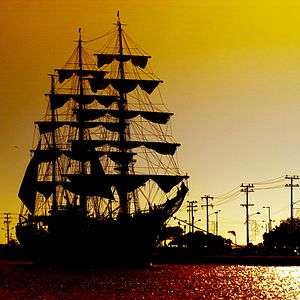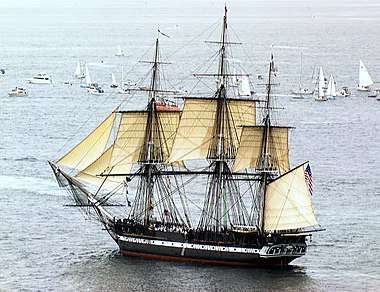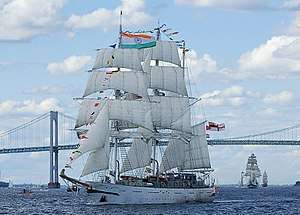Sailing ship

The term "sailing ship" is most often used to describe any large marine vessel that uses sails to harness the power of wind.
A "ship-rigged" sailing ship specifically refers to a vessel that carries three or more masts with square sails on each.[1] Other large sailing vessels, that are not ship-rigged, may be more precisely referred to by their sail rig, such as schooner, barque (also spelled "bark"), brig, barkentine, brigantine or sloop.[2]
Characteristics

There are many different types of sailing ships, but they all have certain basic things in common. Every sailing ship has a hull, rigging and at least one mast to hold up the sails that use the wind to power the ship.
The crew who sail a ship are called sailors or hands. They take turns to take the watch, the active managers of the ship and her performance for a period. Watches are traditionally four hours long. Some sailing ships use traditional ship's bells to tell the time and regulate the watch system, with the bell being rung once for every half hour into the watch and rung eight times at watch end (a four-hour watch).[4][5]
Ocean journeys by sailing ship can take many months, and a common hazard is becoming becalmed because of lack of wind, or being blown off course by severe storms or winds that do not allow progress in the desired direction. A severe storm could lead to shipwreck, and the loss of all hands.
Sailing ships are limited in their maximum size compared to ships with heat engines, so economies of scale are also limited. The heaviest sailing ships (limited to those vessels for which sails were the primary means of propulsion) never exceeded 14,000 tons displacement. Sailing ships are therefore also very limited in the supply capacity of their holds, so they have to plan long voyages carefully to include many stops to take on provisions and, in the days before watermakers, fresh water.
Types of sailing ships
There are many types of sailing ships, mostly distinguished by their rigging, hull, keel, or number and configuration of masts. There are also many types of smaller sailboats not listed here.[6] The following is a list of vessel types, many of which have changed in meaning over time:
|
|
Automated sailing
In 1902 the sailing vessel Preussen was the first to assist handling of sails by making use of steam power without auxiliary engines for propulsion. The steam power was used to drive the winches, hoists and pumps. A similar ship Kruzenshtern, a very large sailing vessel without mechanical assists, had a crew of 257 men, compared to the Preussen, which required only 48 men.[7]
In 2006, automated control had been taken to the point where sails could be operated by one person using a central control unit, DynaRig. The DynaRig technology was first developed in the 1960s in Germany by W. Prolls as a propulsion alternative for commercial ships to prepare for a possible future energy crisis. The technology is a high-tech version of the same type of sail used by the Preussen, the "square-rigger". The main difference is that the yards do not swing around a fixed mast but are rigidly attached to a rotating mast. DynaRig along with extensive computerization was used in the proof-of-concept Maltese Falcon to enable it to be sailed with no crew aloft.[7]
As of 2013, with increasing restrictions on use of bunker fuel, attempts were underway to develop hybrid sailing ships using automated sail and alternative fuels.[8]
Gallery
.jpg) Götheborg is a sailing replica of the Swedish East Indiaman Götheborg I
Götheborg is a sailing replica of the Swedish East Indiaman Götheborg I
 Star of India, a full-rigged iron windjammer, built in 1863, restored 1963, is a seaworthy museum ship in San Diego.[9]
Star of India, a full-rigged iron windjammer, built in 1863, restored 1963, is a seaworthy museum ship in San Diego.[9].jpg) The Cutty Sark is the only surviving clipper ship, permanently dry-docked in Greenwich, England,.[10]
The Cutty Sark is the only surviving clipper ship, permanently dry-docked in Greenwich, England,.[10] Sailing ships tied to shore, circa 1900-1920
Sailing ships tied to shore, circa 1900-1920
.jpg) ‘Sail in Company’ during International Fleet Review 2016, Visakhapatnam
‘Sail in Company’ during International Fleet Review 2016, Visakhapatnam_-_SLV_H91.250-725.jpg)
See also
References
- ↑ Quiller-Couch, Arthur Thomas (1895). The Story of the Sea. 1. Cassell and Company. p. 760.
- ↑ Parker, Dana T. Square Riggers in the United States and Canada, pp. 6-7, Transportation Trails, Polo, IL, 1994. ISBN 0-933449-19-4.
- ↑ Parker, Dana T. Square Riggers in the United States and Canada, p. 12, Transportation Trails, Polo, IL, 1994. ISBN 0-933449-19-4.
- ↑ Tony Gray. "Workshop Hints: Ship's Bells". The British Horological Institute. Archived from the original on 9 November 2012. Retrieved 12 June 2011.
- ↑ "Ship's Bell". National Maritime Museum. Archived from the original on 9 December 2008. Retrieved 2008-04-07.
- ↑ "Classes and Equipment". International Sailing Federation. Retrieved 17 June 2011.
- 1 2 lowtechmagazine.com - Sailing at the touch of a button, 2009-04-13
- ↑ Robert Wall (July 10, 2013). "Rolls-Royce Revives Age of Sail to Beat Fuel-Cost Surge: Freight". Bloomberg. Retrieved July 11, 2013.
Cargo vessels are set for a design change embracing sleeker hulls and hybrid propulsion systems, according to London-based Rolls, which is helping to develop a ship featuring a 180-foot sail augmented by bio-methane engines and carrying 4,500 tons
- ↑ Parker, Dana T. Square Riggers in the United States and Canada, p. 59, Transportation Trails, Polo, IL, 1994. ISBN 0-933449-19-4.
- ↑ "Cutty Sark," Royal Museums Greenwich Web site (http://www.rmg.co.uk/cuttysark). Retrieved July 29, 2014.
- ↑ Parker, Dana T. Square Riggers in the United States and Canada, p. 45, Transportation Trails, Polo, IL, 1994. ISBN 0-933449-19-4.
- ↑ Parker, Dana T. Square Riggers in the United States and Canada, p. 25, Transportation Trails, Polo, IL, 1994. ISBN 0-933449-19-4.
Further reading
- [Lukin, James] (1882). The History of a Ship from Her Cradle to Her Grave: With a Short Account of Modern Steamships and Torpedoes (New ed.). London: George Routledge & Sons.
- [Anderson, Romola.] (1882). The sailing-ship : six thousand years of history (New ed.). New York: R. M. McBride.
External links
| Look up sailing ship in Wiktionary, the free dictionary. |
![]()